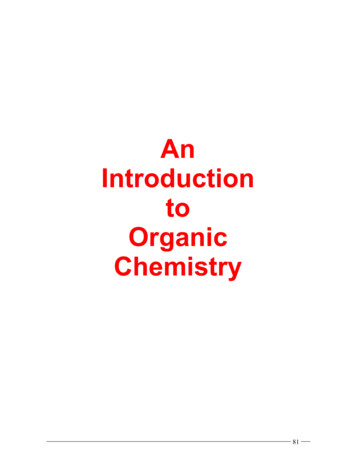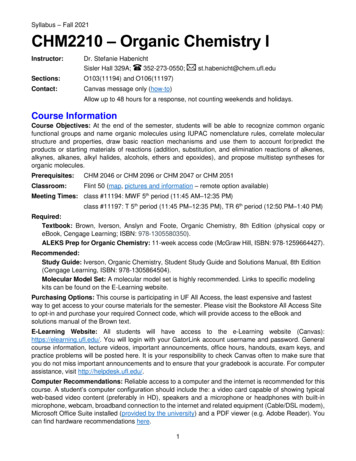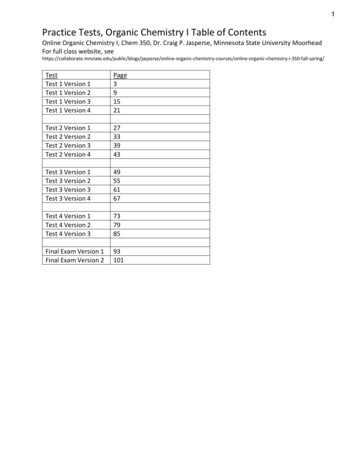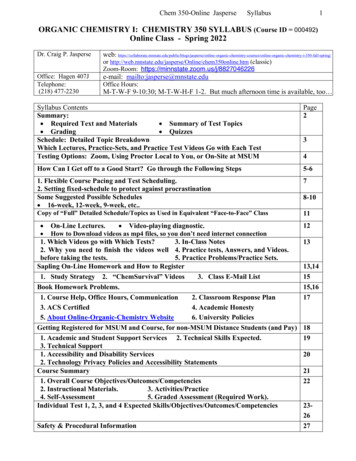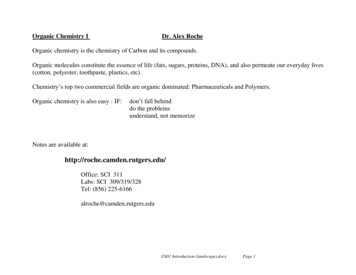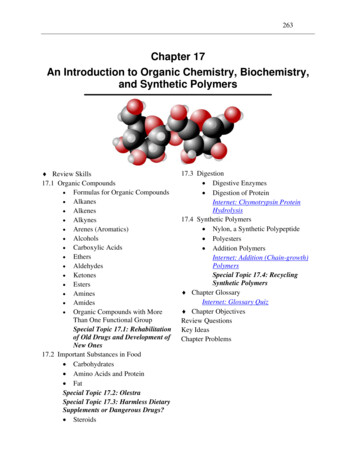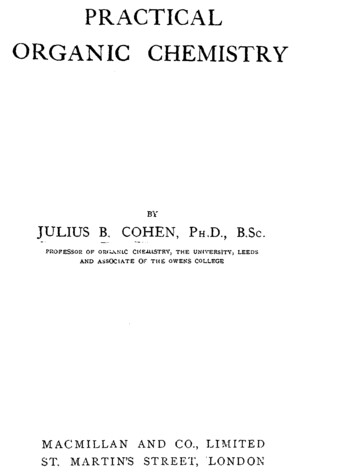
Transcription
P R A C T I C A LO R G A N I CC H E M I S T R YBYJ U L I U S B. C O H E N , P H . D . , B . S C .PROFESSOR OF ORGANIC CHEMISTRY, THE UNIVERSITY, LEEDSAND ASSOCIATE OF THE OWENS COLLEGEM A C M I L L A N AND CO., L I M I T E DST. MARTIN'S STREET, LONDON
RICHARD CLAY AUD SONS, LIMITED.,BREAD STREET HILL, E.C, ANDBUNGAY, SUFFOLK.First Edition, 1900.Reprinted 1904, 1907.Second Edition 1908, 1910.
P R E F A C E T O T H E FIRST EDITIONTHE present volume is an enlarged edition of that publishedin 1887, and has been completely rewritten. The preparationshave all been carefully revised, some of the former onesomitted and many new ones introduced. The chief additionsare the introductory chapters on organic analysis and molecularweight determinations, and an extension of the appendix.The book does not aim at being a complete laboratory guide,but is intended to provide a systematic course of practical instruction, illustrating a great variety of reactions and processeswith a very moderate outlay in materials and apparatus.The objection may be raised that the detailed description ofprocesses makes no demand upon a student's resourcefulnessor ingenuity. It must be remembered, however, that themanipulative part of organic chemistry is so unfamiliar to theelementary student that he requires minute directions in orderto avoid waste of time and material. Until he.has acquiredconsiderable practical skill he cannot accomplish the experimental work requisite for research, and repeated failures will beapt to destroy his confidence in himself.To satisfy, to a.legitimate extent, the prejudices of certainexamining bodies, who still adhere to the old system of testinga student's knowledge of practical organic chemistry by meansof the qualitative analysis of certain meaningless mixtures, thespecial tests for some of the more common organic substanceshave been inserted. At the same time, an attempt has beenat the end of the appendix to systematise the analysis of
PREFACE TO THE FIRST EDITIONorganic substances on a broader and therefore more rationalbasis.The present occasion seems opportune to direct attention tothe fact that one of the most familiar, most readily procurableand most cheaply produced of all organic materials is placedbeyond the reach of many students by the heavy duty leviedupon it. May I, in the name of teachers of organic chemistry,appeal to the Board of Inland Revenue, on behalf of scientificand technical education, to provide institutions for highereducation in science with a limited quantity of pure alcoholfree of duty, thereby placing schools of chemistry in thiscountry in the same position as those on the Continent ?In conclusion I desire to thank Dr. J. McCrae, who haswritten the section on Ethyl Tartrate and the use of the Polarimeter, Dr. T. S. Patterson, who has been kind enough to look over the proofs, and Mr. H. D. Dakin, who has given me substantial assistance in the practical work of revision.J. B. COHEN.THE YORKSHIRE COLLEGE,October; 1900.
PREFACE TO T H E SECONDEDITIONIN the former edition attention was drawn to certaindrawbacks which accompanied the study of practical organicchemistry, among which the heavy duty on alcohol and theunsatisfactory nature of the practical tests demanded bypublic examining bodies were specially emphasised.Teachers and students alike must welcome the changes whichhave since taken place. An excise duty on alcohol used in thelaboratory is no longer exacted from students of science, andsubstantial reforms have been introduced into practical examinations.One important feature in some of the new examinationregulations is the recognition of the candidate's signed recordof laboratory work. We are, in fact, beginning to discover aninherent .defect in practical chemistry as an examination subject, namely, its resistance to compression into a compactand convenient examination form.The old and drastic method by which chemistry was made tofit into a syllabus consisted in cutting out the core of thesubject, or in other words, in removing all the processes whichdemanded time, skill, and some intelligence, and in reducing theexamination to a set of exercises in a kind of legerdemain. Thisprocess has been to a large extent abandoned, but a residuumof it s.till remains. It is to be hoped that the kind of practicalexamination in organic chemistry, which consists in allottinga few hours to the identification of a substance selected froma particular list, will in time be superseded or accompaniedby a scheme encouraging candidates to show, in additionto tfceir note-books, evidence of skill and originality, as, for
viiiPREFACE TO THE SECOND EDITIONexample, in submitting specimens of new or rare preparations, orin presenting an account of some small investigation.The present edition is much enlarged and contains new preparations, reactions and quantitative methods, all of which havebeen carefully revised. My object has been not to follow anyparticular syllabus, but to present a variety of processes fromwhich a selection may be made to suit the special needs ofdifferent students.My thanks are due to Mr. Joseph Marshall, B.Sc, andseveral of my senior students, for their assistance in the work ofrevision.J. B. COHENTHE UNIVERSITY, LEEDS.July, 1908.
CONTENTSORGANIC ANALYSIS—PAGEQualitative examinationCarbon and HydrogenNitrogenThe HalogensSulphurPhosphorusQuantitative estimationCarbon and HydrogenNitrogenThe Halogens,SulphurDetermination of molecular weightVapour density methodCryoscopic or Freezing-point methodEbullioscopic or Boiling-point methodMolecular weight of acidsMolecular weight of ral remarksPurification of spiritEthyl alcoholPotassium ethyl sulphateCrystallisation .Ethyl bromide;474849. 505254
CONTENTSPREPARATIONS—Dehydration of liquidsDetermination of specific gravity,,boiling-pointEtherPurification of commercial etherEthylene bromideAcetaldehydeMethyl alcoholMethyl iodideAmyl alcoholAmyl nitriteAcetone, .ChloroformAcetoximeMelting-point determinationAcetic acidAcetyl chlorideAcetic anhydride. . . . . .AcetamideHeating under pressure. . .AcetonitnleMethylamine hydrochloride (Hofmann's reaction) . . .Ethyl acetate . .Ethyl acetoacetateDistillation in vacuoMonochloracetic acidMonobromacetic acidGlycocollGlycocoll ester hydrochloridePreparation of hydrogen chlorideDiazoacetic esterDiethyl malonate .Ethyl malonic acidChloral hydrateTrichloracetic acid,Oxalic acid . 1 38487899092939496979999 00
CONTENTSPREPARATIONS—Methyl oxalateGlyoxylic and Glycollic acidsPalmitic acidGlycerolFormic acidDistillation in steamAllyl alcoholIsopropyl iodideEpichlorhydrinMalic acidSuccinic acidTartaric acidEthyl tartrateDetermination of rotatory powerRacemic and Mesotartaric acid.Resolution of Racemic acid (Pasteurs method) . . .Pyruvic acidCitric acidCitraconic and Mesaconic acidUreaThiocarbamideUric acidAlloxantinAlloxanCaffeineCreatineTyrosinc and Leucine (E. Fischer's ester method) . . .Grape sugarBenzenePurification of BenzeneFractional distillationBromobenzeneEthyl benzeneNitrobenzeneAzoxybenzeneElectrolytic reduction of 613613614 141T 24r43144
lytic reduction of hydroxylamine148Nitrosobenzene149j -Aminophenol. 149Aniline149Acetanilide151 -Bromacetanilide152/-Nitraniline1557//-D 57Thiocarbanilide159Phenyl thiocarbimide160Triphenylguanidine160Diazobenzene sulphate161Toluene from/-toluidine163/-Cresol164/-Chlorotoluene165 -Chlorobenzoic hloride169Iodosotoluene169p -Tolylcyanide159S T l i acidjyojyoTerephthalic lhydrazinely Phenyl methyl pyrazolone (Knorr's reaction) . . . . 175Sulphaniltc acidx -
CONTENTSPREPARATIONS—PAGEMethyl orange . 176Potassium benzene sulphonate177Benzenesulphonic chloride 178Benzene sulphonamide179Phenol179Anisole181Hexahydrophenol (Sabatier and Senderens5 reaction) . 181 0- and jz -Nitrophenoll 3Picric acid185PhenolphthaleinV !86Fluorescein and Eosin187Salicylaldehyde and -Hydroxybenzaldehyde (Reimer'sreaction) 188Salicylic acid (Kolbe's reaction)190Quinone and Quinol192Benzyl chloride194.Benzyl alcohol195Benzaldehyde196a- and /3-Benzaldoximes197Benzoic acid199Nitro-, Amino-, and Hydroxy-benzoic acid . . . . . . 200w-Bromobenzoic acid201Benzoin202B'enzil203Benzilic acid203Cinnamic acid (Perkin's reaction)204Hydrocinnamic acid 204Mandelic acid205Phenyl methyl carbinol (Grignard's reaction)206Benzoyl chloride208- Benzamide209Ethyl benzoate209Quantitative hydrolysis of ethyl benzoate210Acetophenone (Friedel-Crafts3 rbazone212
jjvo NTI:\ r PREPARATIONS -Beckmann's reactionBenzoylacetone (Claisen's re.t !i ;i. Diphenylmethane.Triphenyl methaneMalachite greenNaphthalene . .Phthalic acid5-Naphthalencsulphonate of sodium/3-NaphthoIEstimation of methoxyl (ZeiscP mcthn.i} .„,, acetoxyl (A. (I. !Vrkin\ mt-'in!„„ hydroxyl ('rsthi!i;ai'J'f N nirti.M :Naphthol yellowAnthraquinoneAnthraquinone /i-monosulphon;itc n\' .nht:::,AlizarinIsatin from indigoQuinolineQuinine sulphate from c.inchoii.j h.n!;. . .Phenylmethyltriazole carlioxylit a i»i . . . .APPENDIX. Notes on the Prcpar.aionn. . . .HINTS ON THK INVKSTIUATION HF t )i: ; \M, S? J: i \N.TABLESIN'DEX
ORGANICANALYSISQualitative Examination.Carbon and Hydrogen.—Carbon compounds are frequently inflammable, and when heated on platinum foil taken*i?e or char and burn away. A safer test is to heat the substancewith some easily reducible metallic oxide, the oxygen of whichforms carbon dioxide with the carbon present. Take a piece ofsoft glass tube about 13 cm. (5 in.) long, and fuse it togetherat one end. Heat a gram or two of fine copper oxide in aporcelain crucible for a few minutes todrive off the moisture, and. let it coolin a desiccator. Mix it with aboutone-tenth of its bulk of powdered sugarin a mortar. Pour the mixture intothe tube, the open end of which is nowdrawn out into a wide capillary andoen'L at the same time into the formFIG. I.shown in Fig. r. This is done byshaking down the mixture to the closed end and revolving thetube in the blow-pipe flame about 2\ cm. (1 in.) beyond themixture until it is thoroughly softened. The tube is thenremoved from the flame, drawn out gently and bent. Make afile scratch across the end of the capillary and break it. Whenthe. tube is cold tap it horizontally at the edge of the bench, soas to orm a free channel above the mixture. Suspend it by aCOHEN'S ADV. P. O. C.B
PRACTICAL ORGANIC CHEMISTRYcopper wire to the ring of a retort stand, and let the open enddip into lime or baryta water. Heat the mixture gently with asmall flame. The gas which bubbles through the lime waterturns it milky. Moisture will also appear on the sides of thetube, which, provided that the copper oxide has been thoroughlydried beforehand, indicates the presence of hydrogen in thecompound. Gases, or volatile substances like ether andalcohol, cannot, of course, be examined .in this way ; butan apparatus must be arranged so that the gas or vapour ismade to pass over a layer of red hot copper oxide and thenthrough the lime water.Nitrogen.—Many organic nitrogen compounds whenstrongly heated with soda-lime give off their nitrogen in theform of ammonia. Grind up a fragment of cheese or a fewcrystals of urea with 5 to 6 times its weight of soda-lime, pourthe mixture into a small test-tube (preferably of hard glass) andcover it with an equally thick layer of soda-lime. Heat strongly,beginning at the top layer. Ammonia is evolved and can bedetected by the smell, or by holding a piece of moistenedred litmus paper at the mouth of the tube. When nitrogen ispresent in direct combination with oxygen, as in the nitro- andazoxy-compounds, ammonia is not evolved. The followinggeneral method is applicable to all compounds and is therefore more reliable. The compound is heated with metallicpotassium or sodium when potassium or sodium cyanideis formed. The subsequent test is the same as for cyanides.Pour* about 10 c.c. of distilled water into a small beaker.Place a fragment of the substance in a small test-tube alongwith a piece of metallic potassium or sodium the size ofa coffee bean, and heat them at first gently until the reaction subsides, and then strongly until the glass is nearlyred-hot. Then place the hot end of the tube in the smallbeaker of water. The glass crumbles away, and any residualpotassium is decomposed with a bright flash, all the cyaniderapidly goes into solution, whilst a quantity of carbon remainssuspended in the liquid. Filter through a small filter into a testtube. Add to the clear solution a few drops of ferroussulphate solution, and a drop of ferric chloride, boi'I up fora minute, cool under the tap, and acidify with dilute hydrochloric acid. A precipitate of Prussian blue indicate3 the
QUALITATIVE EXAMINATIONpresence of nitrogen. If the liquid has a blue colour, let itstand for an hour and examine it again for a precipitate. If noprecipitate appears and the solution remains of a clearyellowish-green colour, no nitrogen is present.If sulphur is present, an excess of alkali metal must beused to prevent the formation of sulphocyanide.The Halogens.—Many halogen compounds impart a greenfringe to the outer zone of the non-luminous flame. A moredelicate test is to heat the substance with copper oxide(Beilstein). Heat a fragment of copper oxide, held in the loopof a platinum wire, in the outer mantle of the non-luminousflame until it ceases to colour the flame green. Let it cool dovyna little and then dust on some halogen compound (bromacetanilide will serve this purpose, see Prep. 55, p. 152). Nowheat again. A bright green flame, accompanied by a blue zoneimmediately round the oxide, indicates the presence of ahalogen. The halogen in the majority of organic compoundsis not directly precipitated by silver nitrate. Only thosecompounds which, like the hydracids and their metallic salts,dissociate in solution into free ions give this reaction. If,however, the organic compound is first destroyed, and thehalogen converted into a soluble metallic salt, the test may beapplied. JHeat the substance with a fragment of metallic sodiumor potassium as in the test for nitrogen, p. 2. The test-tubewhilst hot is placed in cold water, the alkaline solution filtered,acidified with dilute nitric acid and silver nitrate solution added.A curdy, white or yellow precipitate (provided no cyanide ispresent), indicates a halogen. If a cyanide is present, boil withnitric acid until the hydrogen cyanide is expelled and addsilver nitrate.Sulphur.—The presence of sulphur in organic compoundsmay be detected by heating the substance with a little metallicsodium or potassium. The alkaline sulphide, when dissolved inwater, gives a violet colouration with a solution of sodium nitroprusside. Heat a fragment of gelatine with a small piece ofpotassium in a test-tube until the bottom of the tube is red hot,and place it in a small beaker of water as described in the testfor nitrogen (p. 2). Filter the liquid and add a few drops ofsodium nitroprusside solution.Phosphorus.—The presence of phosphorus is ascertainedB2
4PRACTICAL ORGANIC CHEMISTRYby heating the substance strongly with magnesium powder andmoistening the cold product with water. Magnesium phosphideis formed and is decomposed by the water, giving phosphinewhich is readily detected by its smell.Quantitative Estimation.Carbon and Hydrogen.—The principle of the method isthat described under qualitative examination, but the substanceand the products of combustion, viz., carbon dioxide and water,are weighed. The following app'aratus is required.1. An Erlenmeycr or other form of Co?nbustion Fii?'?iace.—The usual length is 80-90 cm. (31-35 in.), and it is provided with30 to 35 burners. Flat flame burners are undesirable.2. A Drying Apparatus.—A form of drying apparatus whichis easily fitted together is shown in Fig. 2. It consists of fourlarge U-tubes arranged side by sidein pairs. The U-tubes are mountedupon a wooden stand with two uprights, to which the two pairs of tubesare wired. The first of each pair isfilled with soda-lime, and the secondwith pumice soaked in concentratedsulphuric acid. Each soda-lime tubeFIG. 2.is connected with a sulphuric acid tubeby well-fitting rubber corks and a bent glass tube. The twoother limbs of the sulphuric acid U-tubes are joined by a threeway-tap forming a T-piece. The free end of the T-piece isattached to a small bulbtube, Fig. 3, containing adrop of concentrated sulphuric acid to mark therate at which the bubblesare ri smg through theFIG. 3.SThe e i& -connect with the combustion tube by a shortM fce of rubber ru]?ing and a short glass tube, which passesthrough a rubber cork fixed in the end of the combustion tube.The rubber'tubing carries a screw-clip. The open enois of
QUANTITATIVE ESTIMATIONthe soda-lime U-tubes are closed with rubber corks, throughwhich pass bent glass tubes. One of these glass tubes is connected by rubber tubing to an oxygen gas-holder or to acylinder of compressed oxygen, which must be furnished withan automatic regulating valve, and the other glass tube isattached to a gas-holder containing air. By turning the threeway tap, either oxygen or air may be supplied to the combustiontube.3. A Combustion Tube of Hard Glass.—It should be about 13mm. inside diameter, and the walls not more than 1*5 mm.thick. Its length should be such that it projects at least 5 cm.(2 in.) beyond the furnace at either end. After cutting therequired length, the ends of the tube are carefully heated in theflame until the sharp edges are just rounded. The tube is filled- - follows. Push in a loose asbestos plug about 5 cm. (2 in.) fromasFIG. 4.one end. This end, to which the calcium chloride tube and potashapparatus are subsequently attached, may be called the front end.Pour in coarse copper oxide at the opposite end and shake it downto the plug until there is a layer about two-thirds the length of thetube. Keep the oxide in position by another plug of asbestos ;see that the plugs are not rammed too tight. Make a roll ofcopper gauze about 13 cm. (5 in.) long to slide easily into theback end of the combustion tube. This is done by rolling- thegauze tightly round a stout copper wire until the requisite thickness is obtained. The projecting ends of the wire are thenbent over into hooks as shown in Fig. 4. This roll, or spiral,as it is usually called, is subsequently oxidised. It is pushedinto the tube or withdrawn as occasion requires by a piece ofhooked wire. The combustion tube is placed on a layer ofasbestos in the iron trough of the furnace. The arrangement ofthe tube with boat and spiral is shown in Fig. 5.4. A Straight Calcium Chloride Tube.—It is insertec tnYough arubber cork and fixed in the front end of the combustion tubewhen the latter is not in use, as copper oxide is very hygroscopic, and it is necessary to protect it from the moisture inthe air.
PRACTICAL ORGANIC CHEMISTRY5. A Potash Apparatus.—Several forms of potash apparatusare made ; that of Geissler (Fig. 6), and Classen (Fig. 7) beingperhaps most commonly employed. The latter has the advantage of being very light. The removable side tube is rilledwith granulated calcium chloride or soda-lime, with a plug ofcotton wool at each end. The bulbs of the apparatus are filledFIG. 5with a strong solution of caustic potash containing 25 grams ofpotash to 50 c.c. of water. This is done as follows. Removethe soda-lime tube and attach in its place a piece of rubbertubing. This serves as a mouthpiece. Pour the potashsolution into a basin and dip the other end of the potashapparatus under the liquid. Suck at the rubber tube until thequantity appears sufficient to fill the bulbs. Remove thepotash solution and continue to suck until the solution is transferred to the bulbs. The bulbs should be nearly filled. In thecase of Classen's apparatus, the liquid should stand half an inchdeep in the bottom of the apparatus outside the lowest bulb.FIG. 6FIG.Wipe the potash solution from the outside and inside of theinlet tube of the apparatus with filter paper. Smear a thin filmof vaseline on the ground end of the soda-lime tube beforereplacing it, and fit to the open ends of the apparatus, stoppersof rubber and glass rod, which are not removed, except whenthe apparatus is in use. As the potash apparatus has 6 be
QUANTITATIVE ESTIMATIONrefilled after every two combustions, it is advisable to keep a littlstock of solution in a bottle fitted with an ordinary cork6. A Calcium Chloride U- Tube.—The form of calcium chloridetube is shown in Fig. 8. It is fitted with sieved calciumchloride to within i\ cm. (i in.) of theside pieces, and then with coarser piecesto within \ cm. (i in.). Place a smallplug of cotton wool in both limbs abovethe chloride to keep it in position. Twowell-fitting corks, cut off level with theglass and coated with sealing-wax, produce an effective air-tight stopper to theFIG. 8.open limbs, but it is preferable to sealthem in the blow-pipe flame. The sealing requires a little skill.Carefully wipe off any chloride dust which may have adheredto the open ends of the two limbs. Cork up one limb andstopper one of the side tubes. Attach a short piece of rubbertubing to the other side tube to serve as a mouthpiece. Nowsoften the end of the open limb in a small blow-pipe flame, andat the same time heat the end of a short piece of glass rod.With the hot end of the rod gather up the edges of the openlimb, and whilst rotating the limb backwards and forwards inthe flame, draw it out and seal it up. If successful, the appearance of the tube is that shown in Fig. 9. The blob of glass isheated in a small flame, and, by gently blowing and re-heatingand blowing again, the blob can beremoved, and, finally, by using arather larger flame, heating andblowing alternately, the end isneatly rounded.7. A Porcelain or, preferably aPlatinum, Boat.—See that it slipseasily into the combustion tube.FIG. 9.The boat is kept in a desiccatoron a flat cork or support made of glass rod when not in use.Preparation of t h e Tube.—Before starting the combustion it is necessary to clean and dry the combustion tube.This is effected by heating the whole length of the tube containing the copper oxide and spiral gradually to a dull red heat,and passing through it a slow stream of dry oxygen from the
PRACTICAL ORGANIC CHEMISTRYgas-holder or cylinder. As soon as a glowing chip is ignited atthe front end and the moisture, which at first collects there, hasdisappeared,-the gas jets are turned down and finally extinguished. The oxygen is then stopped, and the straightcalcium chloride tube inserted into the open end of the tube.Preliminary Operations.—Grind up a little pure oxalicacid, and carefully weigh out 0*15 to 0*2 gram (not more) in theboat Weigh also the calcium chloride tube and potash apparatus without stoppers or other accessories. The side tube ofthe calcium chloride tube, which carries the bulb, is attacheddirectly to the combustion tube with a rubber cork. This corkshould be carefully selected, and should exactly fit the combustion tube. The bore hole should be small and smooth, andit is advisable to dust it with graphite or coat it with a film ofvaseline to prevent the rubber from clinging to the glass, amatter of frequent occurrence unless this precaution is taken.The cork should be kept exclusively for the combustion. Pushthe side tube of the calcium chloride tube through the hole untilit is flush with the opposite surface, and squeeze the cork tightlyinto the combustion tube. Attach the potash apparatus to theother limb of the calcium chloride tube by a well-fitting pieceof rubber tubing about 3 cm. (i in.) long, and bring the endsof the glass as closely as possible together. It should beunnecessary to wind wire round the joint if the rubber is of theright diameter. A little vaseline may be used here with advantage, but only in the thinnest film. The potash apparatuswill require to be supported upon a block or stand. Removethe copper spiral from the back of the tube. Introduce theboat and push it into position against the asbestos plug bymeans of the spiral which is placed behind it. Replace therubber cork connected with the drying apparatus. The apparatuswill present the appearance shown in Fig. 10.It must now be tested to see that it is air-tight. For thispurpose, close the open end of the potash apparatus with atight stopper and turn on the full pressure from either gasholder. After the first few bubbles of air have passed throughthe bulbs of the potash apparatus no further movement ofbubbles should appear in any part of the apparatus. If itwithstands this test, the combustion may proceed. Release thepressure by closing the tap of the gas-holder, screwing i»p the
QUANTITATIVE tclip at the back of the combustion\ e, rrd cautiouslyremovit h e stopper from the potash apparatus f e j f ew a y tap from its socket for a moment. u r. L.OT h e Combustion.—Turn on the oxygen a TaajustThe rateof flow through the apparatus by means of the screw-clip' s ot h a t 2 or 3 bubbles a second pass through the potash bulbs.Throw back the tiles if closed, and light the burners under thefront layer of copper oxide to within 10 cm. (4 in.) of the boata n d also 2 or 3 burners under the spiral behind the boat, butn o t within 5 cm. (2 in.) of the boat. Turn up the gas slowly toavoid cracking the tube and in a minute or two, when the tubeis thoroughly warmed, close the tiles over the lighted burnersa n d heat to a dull red heat. A vivid red heat during thecombustion is not only unnecessary, but undesirable, as thelis apt to soften and be distorted and even to blow out andFIG.10.become perforated. A combustion tuoe carefully handledshould last indefinitely. When the copper oxide is red hot,turn on the burners very gradually from the spiral towards theboat, but do not close the two pairs of tiles over the boat untilt h e combustion is nearly terminated and the burners are alllighted. The first indication of the substance burning is theappearance of a film of moisture at the front end of thecombustion tube and an increase in the speed of the bubblespassing through the potash apparatus. The front end of thetube, which should project 4 to 5 cm. (i to 2 in.) from thefurnace, must be kept sufficiently hot to prevent moisturepermanently condensing there ; but it must never be allowed tobecome so hot that there is any risk of the cork being burnt,and it should always be possible to place the finger and thumb ound the part of the tube where the cork is inserted. A screenm a d e -from a square piece of asbestos board, with a slit in it
I0PRACTICAL ORGANIC CIIKMISTRYslipped over the tube at the end of the furnace, may bewith advantage.# .The speed of the bubbles is the best indication of theof the combustion. If the rate increases so that thepassing through the last bulb cannot easily be counted, nlor burners must be lowered or extinguished until the spslackens. After a time, when the air has been displacedcarbon dioxide largely fills the tube, the gas is nearly allsorbed in the first potash bull). When this occurs, the currentof oxygen maybe increased until the bubbles appear synchronously in the bulbs, when the current is a«ain checked. I fsome copper oxide has been reduced in the first stages of th process, the bubbles in the potash apparatus may entirely reastsfor a time, but will reappear when the copper has been rooxidised. Here again an increased current of oxygen will h a s t e nthe process. The combustion is complete when a glowing eh i j held at the end of the potash apparatus is rekindled. All th *moisture must by now have been driven over into the calnim chloride tube. If this is not the case, warm the end of the ttif »cautiously with a small flame, or by means of a hot tile h o l dnear the tube The time required to complete ihe combustionis about one-half to three-quarters of an hour from the time the*front of the tube is red hot, but more volatile substances, whic:Iimust be heated more cautiously, will naturally take longer.The combustion being complete, gradually turn down, and hrxa few minutes extinguish, the burners. Whilst the furnace cool**the oxygen is replaced by a slow current of air. To do this the?oxygen supply is stopped and the three-way tap is t u r n e dthrough 1800, so as to connect the tube with the air resm-oit-,the tap of which is then opened and the stream of air regulatedby the screw clip.Let the air pass through for 20 minutes whilst the furnace t M»cooling down. Then remove and stopper the potash apparatus.and the calcium chloride tube, and after allowing them to s t a n dby the balance case for half-an-hour, weigh.The results are calculated in percentages of carbon a n dhydrogen as follows :w is the weight of substance taken.a is the increase in weight of the potash apparatus.
QUANTITATIVE ESTIMATIONb is the increase in weight of the calcium chloride tube.12 x a x iooper cent, of carbon.44 x w2 X b X IOO per cent, of hydrogen.18 x «/Example.—0*1510 gram of oxalic acid gave 0*1055 gram ofCO2 and 0*068 gram of H2O.joo 44x0-15100ax. o68xjoo 5 - 00 p e r cent, of hydrogen.X&I8XO-I5IOCalculated for C2H6OG : C 19*04 per cent. ; H 4*76 percent.As a rule, the carbon is a little too low through loss of moisture from the potash apparatus, whilst the hydrogen is too high,probably through incomplete drying of the air and oxygen fromthe gas-holders. The discrepancy should not exceed 0*2 percent, of the theoretica
ORGANIC CHEMISTRY BY JULIUS B. COHEN, PH.D., B.SC. . The book does not aim at being a complete laboratory guide, but is intended to provide a systematic course of practical in-struction, illustrating a great variety of reactions and processes . drawbacks which accompanied the study of practical o

